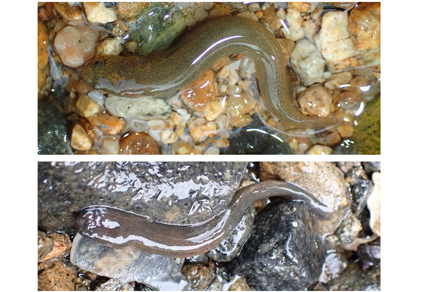Abstract
Two new gobiid fishes of Luciogobius Gill, 1859 have recently been collected from the intertidal waters of the Matsu Islands in Taiwan. The first new species, Luciogobius matsuensis sp. nov., is characterized by the following unique combination of features: (1) second dorsal fin rays: I/12 and anal fin rays I/12; (2) pectoral fin rays modally 16 and with one upper, short free soft ray; (3) vertebral count modally 17+20–21=37–38; and (4) specific coloration: second dorsal fin translucent with tiny brown spots; caudal fin with many tiny brown spots; anal fins pale yellow and translucent, spotless, and darker in its rays; and pectoral fin creamy yellow with anterior 2/3 region with tiny brownish to black spots. The second new species, Luciogobius dongyinensis sp. nov., is characterized by the following unique combination of features: (1) second dorsal fin rays: I/16 and anal fin rays I/16; (2) pectoral fin rays modally 14 and with 2 upper, short free soft rays; (3) vertebral count modally 18+23=41; and (4) specific coloration: a long infraorbital deep brown stripe below eye; a long deep brown stripe above and along upper jaw; pectoral fin with many small patches of melanophores except posterior, distal 1/5 region; and caudal fin brown with many light rounded spots. A brief discussion of their own related species will also be addressed.
References
- Akihito, P., Hayashi, M. & Yoshino, T. (1984) Suborder Gobioidei. In: Masuda, H., Amaoka, K., Araga, C., Uyeno, T. & Yoshino, T. (Eds.), The fishes of Japanese Archipelagos. Tokai University Press, Tokyo, pp. 236–289.
- Akihito, Sakamoto, K., Ikeda, Y. & Sugiyama, K. (2002) Suborder Gobioidei. In: Nakabo, T. (Ed.), Fishes of Japan with Pictorial Keys to the Species. 2nd Edition. Tokai University Press, Tokyo, pp. 1139–1310, 1596–1619.
- Arai, R. (1970) Luciogobius grandis, a new goby from Japan and Korea. Bulletin of National Science Museum (Tokyo), 13, 199–206.
- Chen, I-S. & Fang, L.S. (1999) The Freshwater and Estuarine Fishes of Taiwan. National Museum of Marine Biology and Aquarium Press, Pingtung, 296 pp.
- Chen, I-S. & Kottelat, M. (2005) Four new freshwater gobies of the genus Rhinogobius (Teleostei: Gobiidae) from northern Vietnam. Journal of Natural History, 39, 1047–1429. https://doi.org/10.1080/00222930400008736
- Chen, I-S. & Shao, K.T. (1996) A taxonomic review of the gobiid fish genus Rhinogobius Gill, 1859, from Taiwan, with descriptions of three new species. Zoological Studies, 35, 200–214.
- Chen, I-S., Suzuki T. & Senou H. (2008) A new species of gobiid fish, Luciogobius from Ryukyus, Japan (Teleostei: Gobiidae). Journal of Marine Science and Technology, 16 (4), 248–252. https://doi.org/10.51400/2709-6998.2005
- Chen, J.T.F. (1932) Note sur un nouveau poisson chinois appartenant au genre Luciogobius. Bulletin du Museum National d’Histoire Naturelle (Série 2), 4, 648–650.
- Dôtu, Y. (1957) A new species of a goby with a synopsis of the species of the genus Luciogobius Gill and its allied genera. Journal of Faculty of Agriculture, Kyushu University, 11, 69–76. https://doi.org/10.5109/22676
- Gill, T.N. (1859) Notes on a collection of Japanese fishes, made by Dr. J. Morrow. Proceedings of the Academy of Natural Sciences Philadelphia, 11, 144–150.
- Kanagawa, N., Itai, T. & Senou H. (2011) Two new species of freshwater gobies of the genus Luciogobius (Perciformes: Gobiidae) from Japan. Bulletin of Kanagawa Prefectural Museum (Natural History), 40, 67–74.
- Miller, P.J. (1988) New species of Corcyrogobius, Thorogobius, and Wheelerigobius from West Africa (Teleostei: Gobiidae). Journal of Natural History, 22, 1245–1262. https://doi.org/10.1080/00222938800770761
- Okiyama, M. (2001) Luciogobius adapel, a new species of gobiid fish from Japan. Bulletin of National Science Museum (Tokyo), 27, 141–149.
- Regan, C.T. (1940) The fishes of the gobiid genus Luciogobius Gill. Annals and Magazine of Natural History (Series 11), 5, 462–465. https://doi.org/10.1080/00222934008527060
- Sanzo, L. (1911) Distribuzione delle papille cutanee (organi ciatiforme) e suo valore sistematico nei gobi. Mitteilungen der Zoologischen Station Neapel, 20, 249–328.
- Shiogaki, M. & Dotsu, Y. (1976) Two new species of the genus Luciogobius (Family Gobiidae) from Japan. Japanese Journal of Ichthyology, 23, 125–129.
- Suzuki, T. & Shibukawa, K. (2004) Genus Luciogobius. In: Senou, H. (Ed.), A photographic guide to the gobioid fishes of Japan. Heibonsha Press, Tokyo, pp. 59–60.
- Wongrat, P. & Miller, P.J. (1991) The innervation of head neuromast rows in eleotridine gobies (Teleostei: Gobiidae). Journal of Zoology, London, 225, 27–42. https://doi.org/10.1111/j.1469-7998.1991.tb03799.x


